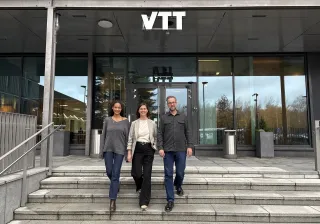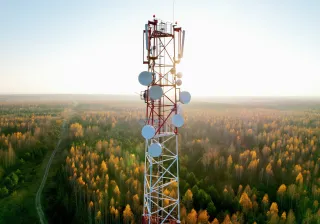The world currently has an enormous need for textile fibre, but all the primary raw materials have problems related either to their sufficiency or oil-based nature. Research Professor Ari Harlin might have a solution to the problem: a textile fibre made from cellulose. Perhaps your future T-shirt might come from the Finnish forest?
Finland has a 150-year history in the forest industry and has been manufacturing viscose fibre since the 1930s. Our production machines are designed to make paper, but today’s need for paper has already dipped below that of cardboard. We have the necessary machinery and forest resources, so why not turn unused paper factories into new plants that produce textile fibre?
These are the thoughts of Ari Harlin, who has been doing long-term research at VTT. Harlin has spent his career working with packaging materials and textiles and he’s also involved in Infinited Fiber Company, a spin-off that got its start at VTT and is commercialising a new textile fibre. VTT was ready to shelve its textile research in the early 2000s, but the researchers decided to give textile fibres one more try. That was a good decision, and VTT has since given rise to another spin-off called Spinnova.
“Never again is usually a very short time on the global scale. We started by considering what we could offer in terms of textiles – and then we remembered the carbamate technology.”
Turning a problem into an opportunity and a vice into a virtue
Carbamate technology was the technique that made it possible to produce new textile fibres from recycled raw materials. VTT originally inherited the technology from Neste, but it was quite complicated at that time. In practice, its use in production would require major investments. The idea behind this stroke of genius was simplifying the process, in other words, turning something mandatory into a virtue. The ammoniac used in the technology was removed from the process because it was not a sustainable solution. The two-stage process was simplified so that it utilised a single reactor instead of two.
Buyers weren’t interested in the technology, so the researchers did a test with recycled newspaper and noticed that it actually produced textile fibre. The next experiment was performed with old Wrangler jeans and it produced the same end result: textile fibre.
Once Harlin and his colleagues had completed the test runs, they only had a small amount of project funding left over. They decided to go to Milan and present the results. It was a successful trip – more than 50 companies showed interest in the technology during a single morning. This proved that they were on the right track, and that’s where the story began. The invention was turned into a spin-off, which marked the beginning of Infinited Fiber.
Brainpower is our real natural resource, and we have to produce something that’s important to the rest of the world.
The first tests were performed at the old Säteri plant in Valkeakoski, where conditions were far from ideal. The plant had been closed for ages, freezing temperatures had left their mark on the building, the water containers froze, and a back-up generator supplied the electricity.
“The atmosphere was a bit James Bond-like and of course this was rather pioneering work,” says Harlin with a laugh as he recalls those chilly workdays.
A decision was eventually made to move the machines to VTT Bioruukki in Espoo. Visitors arriving in the lobby now see a dress made from the new textile fibre, which was also worn by Sirpa Pietikäinen at an Independence Day Reception organised by the President of Finland.

Why are we developing new textile fibres?
The primary objective when developing new textile fibres is ultimately quite simple: to make textiles that are as comfortable, safe and environmentally friendly as possible. People often talk about the clothing industry in conjunction with these new innovations, but textiles are a lot more than clothes – they can also be home textiles, hygiene products or even filters. However, clothing gets a lot of attention because everyone has an intimate relationship with them. Clothes are like a second skin and they also say something about our personality.
Development always starts with a material need and product goal – it’s important to consider what we want to achieve. Technology development is based on pathways. One thing leads to another and then to the next. Finland’s position in the world is a source of deep inspiration.
“We’re located close to the Arctic Circle, and our only natural resources are mostly wood and water rather than huge oil reserves. That’s why we just have to keep on doing things better. Brainpower is our real natural resource, and we have to produce something that’s important to the rest of the world,” says Harlin.
Is this innovation going to take the world by storm? No one knows the answer yet, but the new textile fibres have attracted interest among giant global chains, such as Adidas and H&M. According to Harlin, fibres and textiles will always have a place in the world and that’s why we need to create them. In addition to cellulose-based fibres, other projects include developing a straw-based textile fibre in collaboration with Fortum.
Recycling is always part of this work. The biggest question is how to combine bio-based cellulose fibre and recycled fibre research. Otherwise, we’ll still be promoting single-use culture and additional raw material production, which is devastating for our planet.

Harlin has been part of many projects – now he’s got an eye on the future
Harlin is currently working with transparent cellulose films at VTT. These are the films that should replace the plastic used in packaging and thus prevent the formation of microplastics. The same film can now be applied to cardboard, allowing production of a cardboard mug that can hold liquids without using any plastic – just cellulose on cellulose.
“Cellulose is a great material because it’s found everywhere, it has five structural levels, and it can be constructed and adapted for many different purposes.
Harlin ends the interview with a comment about carbon-negative products – in other words, how to make cellulose without any carbon emissions. Although cellulose is biogenic carbon, the carbon dioxide it releases is still carbon dioxide. If we remove a tree from the forest – are we destroying a carbon storage? Harlin explains that by using emission-free energy and ensuring that the entire carbon content of the tree goes into a product that replaces something oil-based, we’ve created a carbon-negative product that reduces the planet’s carbon dioxide load. This means that in the future the same amount of raw material can produce more and more products to replace fossil carbon. Right now, just over one third of wood becomes material while the remainder is used to produce energy.
“These numbers could be reversed – and that’s not an impossible dream any longer.”
Time will tell what the future holds in store for us.
Research shows that consumers have traditionally had three main criteria for making a purchase decision:
1. Colour
2. Is the clothing item “cool”
3. Price
However, a new factor has now been observed: origin, I.e. where the product comes from. Today’s consumer is interested in a product’s sustainability and responsibility – and many people are also prepared to demand this.





